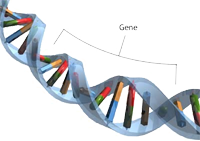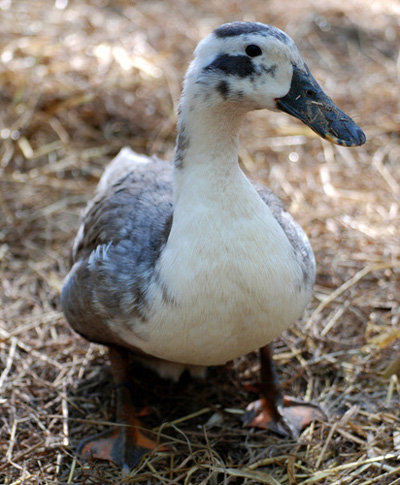 |
Blue
Ancona Duck
Blue is a
blue-gray or darkish gray. There may be red/brown rust on the chest.
Mallard female duck with 1 Extended black allelle + 1 Blue allelle= Blue.
If a Blue drake and Blue female duck breed, you get black, silver and blue
ducklings.
To get all Blue ducklings, you need a Black drake/duck and a Silver duck/drake.
Blue is incompletely dominant. One blue gene with black produces blue. Two
blue genes produces silver. Sometimes a few Black feathers will show with
it.
This photo is a Blue female duck. See Lavender and Lilac below for other
photos of Blue.
|
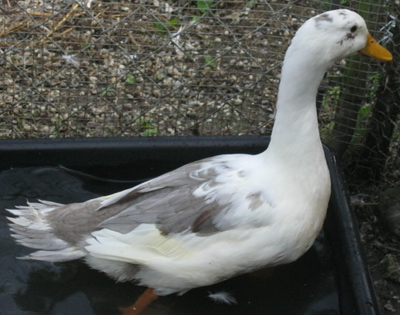 |
Lavender
Ancona Duck
Lavender is
a deep purple-gray or a medium gray. It has a brown undertone. Sometimes
a few Chocolate feathers will show with it.
Chocolate female duck with 1 Blue allelle= Lavender.
This photo is a Lavender drake enjoying a bath.
|
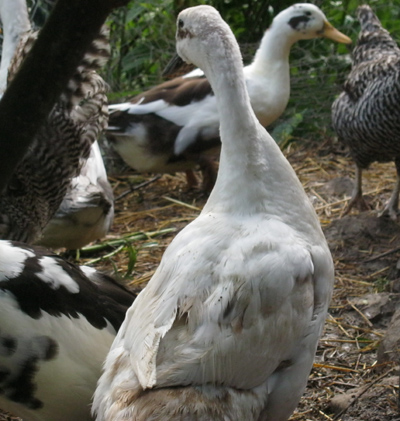 |
Lilac
Ancona Duck
Lilac is a
light shade of lavender. It has a brown undertone. Sometimes a few Chocolate
feathers will show with it.
Chocolate female duck with 2 Blue allelles= Lilac.
This photo is a Lilac hen with a Black duck near her and a Chocolate duck
in the background. |
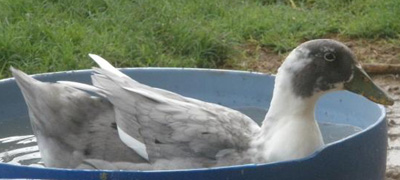 |
Silver
Ancona Duck
Silver is
a very light gray (sort of a dilute Blue). It has a Blue undertone. The
colors are sometimes scattered. It is the rarest color.
Mallard female duck with 1 Extended black allelle + 2 Blue allelles= Silver.
This photo is a Silver female duck.
|
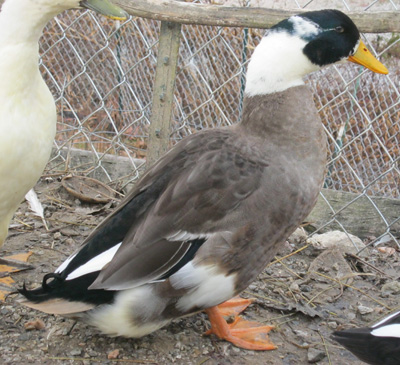
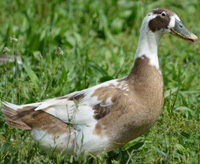
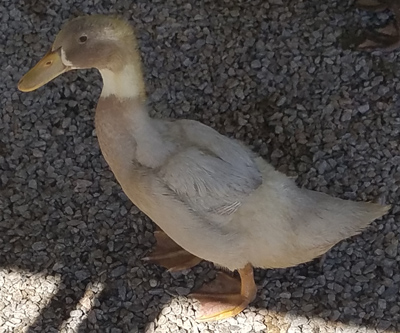 |
Tricolor
Ancona Ducks
Tricolor (Pied)
is any 2 colors plus white.
Tricolor = no Extended Black allele + alleles of other colors.
It is possible to get Tricolor from 2 pure-colored birds. They carry the
colors recessively but not showing in the plumage.
These photos are Tricolors. The first photo is a drake. The second photo is a 6-week-old Fawn and white Tricolor duckling
from Stephanie in Louisburg, North Carolina.
Any color combination is possible. Non-standard colors come from those found
in Runner ducks.
"Tricolor actually means any duck without the Extended Black gene (a throwback). Anconas were developed using Runner ducks (who come in many patterns), and a now extinct breed of duck that carried the Extended Black gene gives you the scattered pattern. Without this Tricolor gene, any color known to occur in Mallard-dev (Mallard-derived ancestry rather than Muscovy) birds can pop up.
Breeding Tricolor Anconas to birds with two copies of the Extended Black gene, will give you 100% of ducklings with the wildly-marked Ancona pattern. Therefore, it is my opinion that Tricolors can work very nicely in a breeding program when used properly.
Further, I care much more about intangible traits such as foraging ability, feed conversion rate, broodiness, winter egg laying ability, growth rate of the males, etc. than I do what color the feathers are. Some of the broodiest duck and best mothers I have had were Wild-type (Mallard) Tricolors.
You won't hurt the breed by choosing to breed Tricolors or not to breed them. There are luckily enough people choosing either option that the breed won't suffer dramatically in either direction. In this situation, we can honestly say to each his own." -Kristy Smith, Worth It Farms, Atlanta, Georgia
|
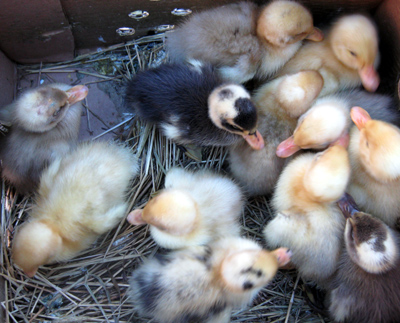
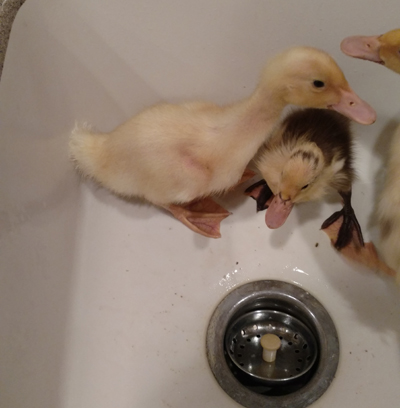 |
Baby
Duckling Colors
The top photo
is an assortment of colors of young Ancona hatchlings. Their feather color
is not fully developed yet.
The darkest at the middle/top is Black. The bottom middle is Black. The
bottom right is Chocolate.
The Blue is the lighter, sort of gray/brown colors. There are 4 of that
color.
There are 5 that look almost all yellow. The Lavender does not show up much
in a photo. You can see a little of it. Lilac does not show much until a
duckling is around 6 weeks old. Silver does not develop very much until
older than 6 weeks with full color development sometimes taking up to 8
months.
"We are in love with our new fuzz balls." -Cheryl, King George, Virginia
The second photo is from Katherine in Urbanna, Virginia. The light-colored
duckling is from one of my blue-green Ancona duck eggs.
|
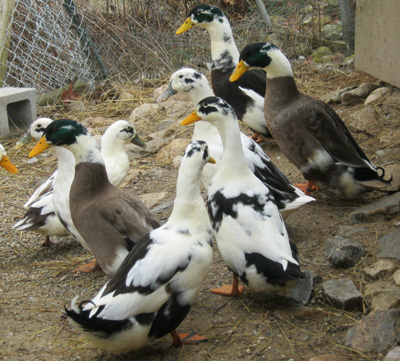 |
White
in Ancona Ducks
Ancona ducks
have two types of white patterning that are overlaid on each other. The
first pattern is a white chest, neck and horizontal line through the eye.
The second is a random, patchy, splotchy, mottled pattern.
An all-white Ancona duck is possible, though rare.
This photo is a group of all Ancona ducks. The Black ducks in the front
have the mottled pattern.
In ducklings their yellow down/feathers slowly turn white as they grow older.
|
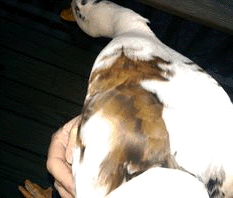
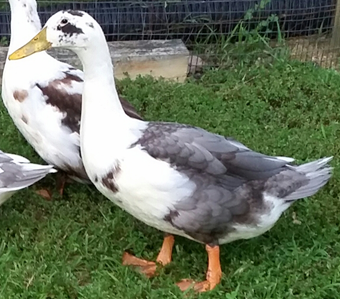
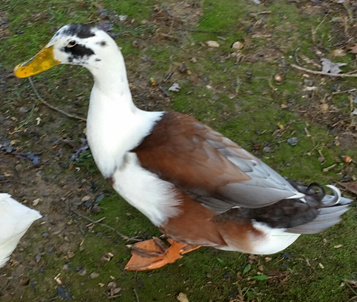 |
Rust
is Not a Color
Rust is a
characteristic of the color patterns sometimes found in Black, Blue and
Chocolate.
Dave Holderread's Breed Bulletin #8502: "Intermating Blacks and Chocolates
normally is satisfactory. Some people think that this combination increases
the occurance of rust or brown in the plumage of Blacks. Rust is a genetically
controlled entity not related to Chocolate. It is true that some Chocolates
do carry rust, but with no greater frequency than the Blacks."
"Because the best-marked individuals carry a single extended Black
allele, Blacks and Blues (especially the drakes) often have reddish brown
shading in the colored portions of their plumage. The rust is considered
a fault in most Black and Blue ducks, but is a necessary characteristic
of the broken pattern." -Storey's Guide to Raising Ducks, p. 147
The first photo is an example of the color 'rust'.
The next two photos are the same male duck. Once when he is young, and the other as an adult.
"Here are
pictures of the drake I kept as my 'pick of the litter'. His juvenile feathers
were all blue without a trace of rust but his full adult feathers are something
much different!! I've had runners over the years with small random patches
of rust here or there on a blue or black colored area, but this guy turned
out really cool. I've never seen anything like it. I think Dave Holderread's
book says rust spreads over generations so maybe he's just a normal blue
and white with a multi-generational accumulation of rust areas but it's
so widespread and symmetrical that I question whether it's really simply
rust.
I was actually planning on making this guy into dinner until the day I noticed the rust coloring because to my eye he is a little too long in the bill, neck and body for correct Ancona proportions. But he did have a good disposition with the hens. So his color saved him long enough for his personality to make him my keeper drake in the end. He's been great.
Betsey the goose was beginning to attack me in front of her nest box a couple nights ago. When Rusty got wind of it, he dashed over and put a stop to it just like I have seen him do when she's gone after one of his hens in a similar way. So I'm really glad I kept this particular drake. I don't think some of the others would have behaved like him. He wasn't a jerk about it, just asserted his rank and she quit wing slapping me!" -Shelley, Gordonsville, Virginia
|
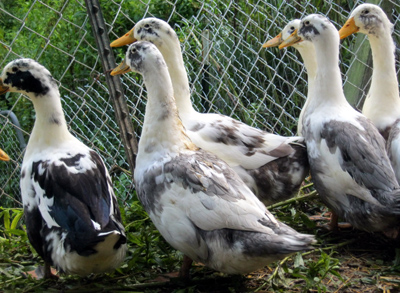
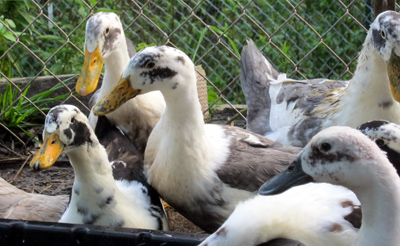
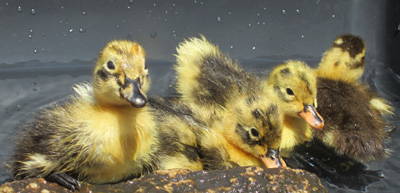 |
Overview
of Ancona Colors
Black
= base (basic) color.
Chocolate (medium brown) = Black + Chocolate allele.
Buff (light Chocolate) = Chocolate + Buff allele.
Blue (blue gray) = Black + Blue allelle.
Lavender (purple gray) = Chocolate + 1 Blue allele.
Lilac (light Lavender) = Chocolate + 2 Blue alleles.
Silver (very light gray) = Black + 2 Blue alleles.
Other colors are possible.
|
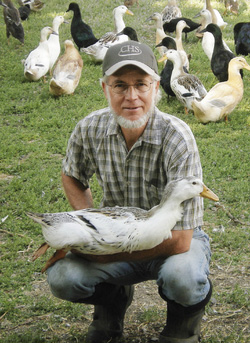 |
Dave
Holderread and Ancona Ducks
This
link is a transcript from an audio tape of David Holderread discussing Ancona
genetics. This is a somewhat complicated discussion for Ancona duck enthusiasts.
David is a waterfowl expert.
Holderread
on Ancona Duck Genetics
|
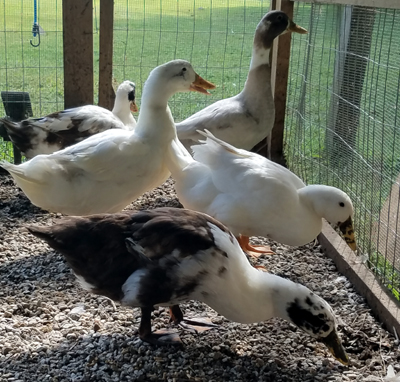
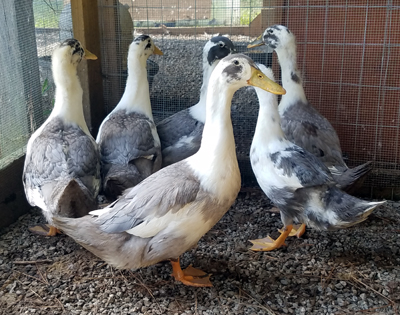 |
Example
of Breeding and Colors
"We
ordered eggs from you last year and hatched 5 ducks. This year, we hatched
6 more ducklings from eggs our original ones laid. I'm including a pic of
the original ones, as the colors in the new ducks look nothing like the
older ducks. Recessive genes, I'm certain." -Stephanie, Louisburg, North
Carolina.
The first photo is the parents. The second photo is the children. Very interesting.
These 2 photos are from Stephanie.
|
David
Holderread, Ancona Duck Breeder
About Green & Blue Duck Eggs
|
